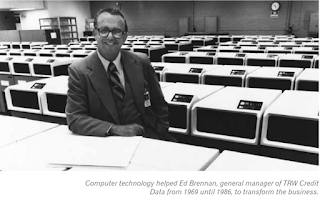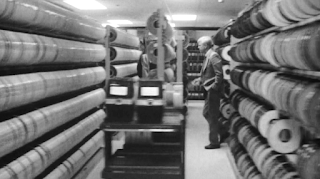This post continues my look back at lessons learned from my career in enterprise IT. My first such job, at Macy’s headquarters in New York City, came to an end in late 1976 when Dorothy and I, now with an infant daughter, Susanna, moved to Southern California.
Dumpster Diving
On my first day, Rick gave me a facility tour, including a walk through that data center. But there was an unusual stop on the tour. Rick took me out behind the data center to the loading dock, where there were several large dumpsters filled with green bar computer printouts to be scrapped. They all had locks on them. He explained that, in the past, criminals had searched through those dumpsters and had obtained access credentials into TRW’s consumer credit database, which they used to steal credit card numbers. This led TRW to secure those dumpsters.
Lesson Learned: Everyone in the enterprise must be security-minded. Many people think IT security and identity theft only became a problem with the dawn of the Internet. Not true: It was a problem back in the 1970s, and TRW took active countermeasures against it. Security not only included technical measures, but also physical security, such as securing dumpsters. Moreover, it was not just outsiders who were a threat. The company was highly sensitive to insider threats—employees inappropriately accessing credit reports, either out of curiosity or for more nefarious reasons. The system monitored all access and audited which employees accessed which credit reports. If you accessed a credit report for no legitimate reason you could be fired on the spot.
A Theoretical Foundation in Software Development
Because of my experience with accounts receivable, Rick assigned me to the subscriber billing system, which was written in COBOL. I also developed new systems for sales reporting and a new system to handle billing for a new credit reporting system acquired by TRW. As I’ll note shortly, I was only at TRW for about 18 months, but I wrote a lot of software.3
It was also a great place to develop my programming and software design skills, with courses taught in house. I also enrolled in several graduate courses at the University of California Irvine (UCI), which was and still is one of the top schools in the country for computer science. It was also convenient, being only about a mile from our home.
My favorite course was Introduction to Software Engineering, taught by
Peter Freeman, who later went to Georgia Tech the become the Founding Dean of the College of Computing. Despite the name, the course was anything but elementary. We covered the work of software luminaries such as Ed Yourdon, Daniel Teichroew, Ed Dijkstra, B. H. Liscov, Michael Jackson, Grady Booch, Fred Brooks, and Glenford Meyers. Professor
Barry Boehm came down from Los Angeles to give one guest lecture—coincidentally he also worked for TRW, in its Defense Systems Group.

The course ended for me on a high note. The final class exercise was to take one of the methodologies we had learned and apply it to a theoretical project. But I had a real project assignment from work—to develop a system to maintain accounting tables for the billing system—and I decided to apply three of the techniques (i.e., HIPO, Structured Design, and Jackson Design) to develop the system. I scored an A+ on the project, and Dr. Freeman wrote to me, in part:
An outstanding project! This project shows much thought and care in its preparation. This perhaps is because you intend to implement the system.
I was most interested in your use of different design techniques depending on what stage of design development you were at. This is quite an innovation. Also, as your critique reveals, this choice gave you the opportunity to evaluate the utility of each of the design techniques used. Impressive.
Keep up the good work (and ask for a raise).
After this class, I was so thirsty for knowledge I applied and was accepted in UCI’s Master’s program for computer science. But with a full-time job and one-year-old Susanna at home, it was more than I could handle, and I never enrolled. Still, I continued to take other classes over the years.
Lesson Learned: Never stop learning. Many of the principles underlying today’s best practices in software development have their roots in principles we learned in those years. For example, object orientation is consistent with Structured Design principles of cohesion and coupling. Although the Agile Manifesto was decades in the future, it had a precursor in Barry Boehm’s promotion of spiral development. And, as I continued my studies, I found myself more and more interested in moving my focus earlier and earlier in the software development process, from coding to system design, to functional design, and to business requirements. This would be a sign of where my career would be heading.
Large Scale Project Management
There is another interesting chapter in the history of TRW Credit Data. As noted earlier, its consumer credit database was one of the largest in the world. In fact, it was so large that we actually needed three databases to cover the U.S.—with an East Coast, Midwest, and West Coast database.
But now, imagine what needed to happen when a consumer moved from one region to another. The system had to move that consumer’s records from one database to another. For this reason, and others, there was a process at the time called “Reorg” that had to run, I believe, weekly. In fact, it took the whole week—when the data center finished one reorg, it started the next one. It was a burdensome tape-oriented process. The 1985 film Prime Risk, mentioned earlier, has one scene as shown in the screen shot nearby, which shows row after row after row of the enormous tape library.
It soon became evident that the entire consumer credit database would need to be rewritten. The project had just been launched when I started with TRW in 1976, under the unassuming name “Project Rewrite.” Shortly thereafter, management gave it a new name, “Project 78.” The reader may guess what the 78 stood for. In any event, the project was was suspended until it was restarted in 1994 as Project Copernicus and completed in 1996 under the project name File One, with a $110M budget and 400+ person project team. As I understand it, the big reason the project was finally completed was that it was a contingency for the leveraged buyout that allowed TRW to spin off the business as Experian.4
Lesson Learned. Manage the schedule. The number one reason projects exceed their budgets is because they do not meet their schedules. Conversely, spending what it takes to push a project over the finish line can be a better choice than letting a project run unconstrained in its schedule and not delivering on its objectives. It also helps when there is a critical business need with no other option, as was the case here. A decades-long project schedule slip is unusual, of course, but the principle applies to more typical projects.
Time to Branch Out from Accounting Systems
As noted earlier, I only stayed at TRW for about 18 months. I was still young in my career, and I was itching for a place where I could continue to develop new skills. Accounting systems were getting boring to me, and I read in Computerworld that there were opportunities in manufacturing. So, I started another job hunt. But that will need to wait for the next chapter.
Footnotes
1Cross country job hunting in 1976 was nothing like it is today. There was no internet, no online job boards, email, or video conferencing. When Dorothy and I decided to relocate, my only information regarding job opportunities was the classified ads in the Los Angeles Times, which I managed to pick up at a NYC newsstand. That at least gave me an idea of what kind of jobs were out there and where they were located. But no employer in SoCal was going to consider, sight unseen, a programmer/analyst candidate with less than three years’ experience from across the country. So, the job hunt really couldn’t begin until I physically relocated.
2The office building (then at 1871 W. Katella, now a strip mall) had originally been some sort of motel, and there was an open courtyard in the middle with palm trees.
Muzak was piped throughout the facility. It was quite a pleasant environment, far from the hustle and bustle of Manhattan. The office building and data center were unmarked, and for good reason. Consumers who had been denied credit based on TRW reports had been known to enter TRW offices and threaten employees. I shared an office, which had originally been a motel room, with another co-worker,
Ken Romans. He was working on the core credit data system and had (and still has) much deeper technical skills than I did. Within the first year, TRW moved the offices from the converted motel to a new midrise office building in The City in Orange. But the data center continued at 1761 W. Katella until 1992, when TRW moved it to Texas.
3In an interesting twist, a family friend worked at TRW decades later. She told me that, during their work remediating the Y2K problem, she heard developers refer to a program as “so old, it must be one of those written by Frank Scavo.” I wonder if any of those programs are still in production.
4There is another twist to this story. The program director who eventually took File One over the finish line was Don Miller. Don was a close friend and associate of Dan Husiak, who came to work for me in 1998 and in 2000 became my business partner and co-founder of Strativa, our management consulting firm. Don became one of our trusted advisors. As a result, other ex-Experian executives came into my network, including Michael Scharf, Don Lavoie, and Will Sproule.
 The course ended for me on a high note. The final class exercise was to take one of the methodologies we had learned and apply it to a theoretical project. But I had a real project assignment from work—to develop a system to maintain accounting tables for the billing system—and I decided to apply three of the techniques (i.e., HIPO, Structured Design, and Jackson Design) to develop the system. I scored an A+ on the project, and Dr. Freeman wrote to me, in part:
The course ended for me on a high note. The final class exercise was to take one of the methodologies we had learned and apply it to a theoretical project. But I had a real project assignment from work—to develop a system to maintain accounting tables for the billing system—and I decided to apply three of the techniques (i.e., HIPO, Structured Design, and Jackson Design) to develop the system. I scored an A+ on the project, and Dr. Freeman wrote to me, in part: 


